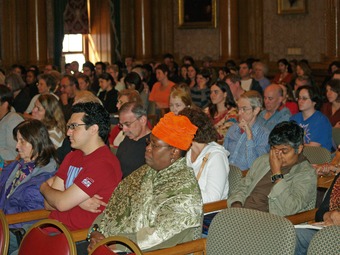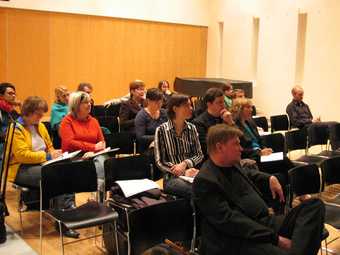7.1: The Importance of Audience Analysis
7.1.1: The Benefits of Understanding Your Audience
The more you know and understand about the background and needs of your audience, the better you can prepare your speech.
Learning Objective
Explain why it is important to understand your audience prior to delivering a speech
Key Points
- Knowing your audience—their general age, gender, education level, religion, language, culture, and group membership—is the single most important aspect of developing your speech.
- Analyzing your audience will help you discover information that you can use to build common ground between you and the members of your audience.
- A key characteristic in public speaking situations is the unequal distribution of speaking time between the speaker and the audience. This means that the speaker talks more and the audience listens, often without asking questions or responding with any feedback.
Key Terms
- Audience-centered
-
Tailored to an audience. When preparing a message, the speaker analyzes the audience in order to adapt the content and language usage to the level of the listeners.
- audience
-
One or more people within hearing range of some message; for example, a group of people listening to a performance or speech; the crowd attending a stage performance.
- audience analysis
-
A study of the pertinent elements defining the makeup and characteristics of an audience.
Benefits of Understanding Audiences
When you are speaking, you want listeners to understand and respond favorably to what you are saying. An audience is one or more people who come together to listen to the speaker. Audience members may be face to face with the speaker or they may be connected by communication technology such as computers or other media. The audience may be small and private or it may be large and public. A key characteristic of public speaking situations is the unequal distribution of speaking time between speaker and audience. As an example, the speaker usually talks more while the audience listens, often without asking questions or responding with any feedback. In some situations, the audience may ask questions or respond overtly by clapping or making comments.

Understanding the Audience
It’s important to understand the audience and generate a clear message before giving a speech.
Audience-Centered Approach to Speaking
Since there is usually limited communication between the speaker and the audience, there is limited opportunity to go back to explain your meaning either during the speech or afterward. When planning a speech, it is important to know about the audience and to adapt the message to the audience. You want to prepare an audience-centered speech, a speech with a focus on the audience.
In public speaking, you are speaking to and for your audience; thus, understanding the audience is a major part of the speech-making process. In audience-centered speaking, getting to know your target audience is one of the most important tasks that you face. You want to learn about the major demographics of the audience, such as general age, gender, education, religion, and culture, as well as to what groups the audience members belong. Additionally, learning about the values, attitudes, and beliefs of the members of your audience will allow you to anticipate and plan your message.
Finding Common Ground by Taking Perspective
You want to analyze your audience prior to your speech so that during the speech you can create a link between you, the speaker, and the audience. You want to be able to figuratively step inside the minds of audience members to understand the world from their perspectives. Through this process, you can find common ground with your audience, which allows you to align your message with what the audience already knows or believes.
Gathering and Interpreting Information
Audience analysis involves gathering and interpreting information about the recipients of oral, written, or visual communication. There are very simple methods for conducting an audience analysis, such as interviewing a small group about its knowledge or attitudes or using more involved methods of analyzing demographic studies of relevant segments of the population. You may also find it useful to look at sociological studies of different age groups or cultural groups. You might also use a questionnaire or rating scale to collect data about the basic demographic information and opinions of your target audience. These examples do not form an all-inclusive list of methods to analyze your audience, but they can help you obtain a general understanding of how you can learn about your audience. After considering all the known factors, a profile of the intended audience can be created, allowing you to speak in a manner that is understood by the intended audience.
Practical Benefits for the Speaker
Understanding who makes up your target audience will allow you to carefully plan your message and adapt what you say to the level of understanding and background of the listeners. Two practical benefits of conducting an audience analysis are (1) to prevent you from saying the wrong thing, such as telling a joke which offends, and (2) to help you speak to your audience in a language they understand about things that interest them. Your speech will be more successful if you can create a message that informs and engages your audience.
7.1.2: What to Look For
Analyze the audience to find the mix of ages, genders, sexual orientations, educational levels, religions, cultures, ethnicities, and races.
Learning Objective
Examine your audience based on demographics
Key Points
- A speaker should look at his or her own values, beliefs, attitudes, and biases that may influence his or her perception of others.
- Guard against egocentrism. A speaker must not regard his or her own opinions or interests as being the most important or valid.
- Look at others to understand their background, attitudes, and beliefs.
- Focus on audience demographics such as age, gender, sexual orientation, education, religion, and other relevant population characteristics to analyze the audience.
- The depth of the audience analysis depends of the size of the intended audience and the method of delivery.
Key Terms
- egocentrism
-
Preoccupation with one’s own internal world; the belief that one’s own opinions or interests are the most important or valid.
- demographics
-
The characteristics of population such as age, gender, sexual orientation, occupation, education; classification of the characteristics of the people.
Look Inward to Uncover Blinders
A public speaker should turn her mental magnifying glass inward to examine the values, beliefs, attitudes, and biases that may influence her perception of others. The speaker should use this mental picture to look at the audience and view the world from the audience’s perspective. By looking at the audience, the speaker understands their reality.

Magnifying Glass
Speakers should use a metaphorical magnifying glass to examine their values, beliefs, and attitudes.
When the speaker views the audience only through her mental perception, she is likely to engage in egocentrism. Egocentrism is characterized by the preoccupation with one’s own internal world. Egocentrics regard themselves and their own opinions or interests as being the most important or valid. Egocentric people are unable to fully understand or cope with other people’s opinions and a reality that is different from what they are ready to accept.
Understanding Audience Background, Attitudes, and Beliefs
Public speakers must look at who their audience is, their background, attitudes, and beliefs. The speaker should attempt to reach the most accurate and effective analysis of her audience within a reasonable amount of time. For example, speakers can assess the demographics of her audience. Demographics are detailed accounts of human population characteristics and usually rendered as statistical population segments.
For an analysis of audience demographics for a speech, focus on the same characteristics studied in sociology. Audiences and populations comprise groups of people represented by different age groups that:
- Are of the same or mixed genders
- Have experienced the same events
- Have the same or different sexual orientation
- Have different educational attainment
- Participate in different religions
- Represent different cultures, ethnicities, or races
Speakers assess the audience’s attitude – a positive or negative evaluation of people, objects, event, activities, or ideas – toward a specific topic or purpose. The attitudes of the audience may vary from extremely negative to extremely positive, or completely ambivalent. By examining the preexisting beliefs of the audience regarding the speech’s general topic or particular purpose, speakers have the ability to persuade the audience members to buy into the speaker’s argument. This can also help with speech preparation.
Tips for the Speaker
The depth of the audience analysis depends of the size of the intended audience and method of delivery. Speakers use different methods to become familiar with the background, attitudes, and beliefs of audiences in different environments and using various mediums (e.g., videoconferencing, phone, etc). For a small audience, the speaker can simply speak with them in a physical environment. However, the speaker is addressing a larger audience or speaking via teleconferencing or webcasting tools, it may be useful to collect data via surveys or questionnaires.
7.1.3: What to Do with Your Knowledge
Use knowledge about your audience to step into their minds, create an imaginary scenario, and test your ideas.
Learning Objective
Identify with your audience by adopting their perspective
Key Points
- A successful speaker is able to step outside her own perceptual framework to understand the world as it is perceived by members of her audience.
- The speaker engages in a process of first encoding his or her ideas from thoughts into words, then forming a message to be delivered to a group of listeners, or audience. The audience members attempt to decode what the speaker is saying so that they can understand it.
- The better the speaker knows the members of the audience beforehand, the better the speaker can encode a message in a way that the audience can decode successfully.
- One of the most useful strategies for adapting your topic and message to your audience is to use the process of identification to find common ground with them.
- You can use your analysis to create a theoretical, imagined audience of individuals from the diverse backgrounds you have discovered in your audience analysis. Then you can decide whether or not the content will appeal to individuals within that audience.
Key Terms
- Decode
-
to translate the sender’s spoken idea/message into something the receiver understands by using his or her knowledge of language based on personal experience
- encode
-
to turn one’s ideas into spoken language in order to transmit them to listeners
- message
-
the verbal and nonverbal components of language, sent to the receiver by the sender, that convey an idea
Identifying with the listeners
Step in to the minds of your listeners and see if you can identify with them. A successful speaker engages in perspective-taking. While preparing her speech, the speaker steps outside her own perceptual framework to understand the world as it is perceived by members of the audience. When the speaker takes an audience-centered approach to speech preparation, she focuses on the audience and how it will respond to what is being said. In essence, the speaker wants to mentally adopt the perspective of members of the audience in order to see the world as the audience members see it.
Encoding and Decoding
The speaker engages a process of encoding his or her ideas from thoughts into words, and of forming a message which is then delivered to an audience. The audience members then attempt to decode what the speaker is saying so that they can understand it. To better imagine this process, consider the example of encoding and decoding as it applies to the idea of a tree. I know that my audience is in New England and that they are familiar with oak trees. I use the word tree to encode my idea, and because my audience has experienced similar trees, they decode the word tree in the way that I intended. However, I may be thinking about a tree (a palm tree) that is in Hawaii, where I used to live, when I use the word tree to encode my idea. Unfortunately, when my audience decodes my word now, they are still thinking about the oak tree and will not see my palm tree. The audience no longer shares my perspective of the world or my experience with trees.

Encoding Communication
One speaker encodes a message and sends the message. The listener hears the message and decodes it.
Finding Common Ground
The more you find out about your audience, the more you can adapt your message to the interests, values, beliefs, and language level of the audience. Once you collect data about your audience, you are ready to summarize your findings and select the language and structure that is best suited to your particular audience. You are on a journey to find common ground in order to identify with your audience. One of the most useful strategies for adapting your topic and message to your audience is to use the process of identification . What do you and your audience have in common? And, conversely, how are you different? What ideas or examples in your speech can your audience identify with?
Creating a Theoretical, Imagined Audience
Create a theoretical, imagined situation to test your view of an audience for practice. You can use your analysis to create what is called a “theoretical, universal audience. ” The universal audience is an imagined audience that serves as a test for the speaker. Imagine in your mind a composite audience that contains individuals from the diverse backgrounds you have discovered in your audience analysis. Next, decide whether or not the content of your speech would appeal to individuals within that audience. What words or examples will the audience understand and what will they not understand? What terms about your subject will you need to define or explain for this audience? How different are the values and opinions you want your audience to accept from the present attitudes and beliefs they may hold?
Tips for the Speaker
In summary, use your knowledge of the audience to adapt your speech accordingly. Adopt the perspective of the audience in order to identify with them, and test out your ideas with an imagined audience composed of people with the background you have discovered through your research.
7.2: Demographic Factors to Consider
7.2.1: Age
Since individuals of the same generation often share similar values, beliefs, and attitudes, age is an important variable to consider.
Learning Objective
Recognize characteristics of different generations
Key Points
- Individuals who grow up at the same time are a generation and often share many of the same experiences as others of the same age group. They exhibit a set of shared values, beliefs, and attitudes that are important to consider when preparing a speech.
- When you speak to an audience with members of different ages, you are likely to experience a generation gap.
- As new generations seek to define themselves as something apart from the old, they adopt new lingo and slang, allowing a generation to create a sense of division from the previous one.
- It is important to become aware of one’s own biases in order to avoid ageism in your speeches.
- The use of handheld communications technology has created a wide gap between older and younger generations.
Key Terms
- Generation
-
Cohorts of people who were born in the same date range and share similar cultural experience.
- ageism
-
Ageism, or age discrimination is stereotyping and discriminating against individuals or groups because of their age. It is a set of beliefs, attitudes, norms, and values used to justify age based prejudice, discrimination, and subordination.
Age is an Important Audience Characteristic
Age is an important variable to consider when analyzing your target audience. Individuals who grow up at the same time are called cultural generations. They often share many of the same experiences as others of the same age group. An outcome of a cultural generation is a set of shared values, beliefs, and attitudes that are important to consider when preparing a speech. All four of the women in the figure are from different generations and will have had different experiences. Of which generation do you think they are a member? To which generation do you belong?

Understanding Different Generations
Each of these four generations has a different set of values, beliefs, and attitudes.
Generations
Consider the generations living today and some of their associated characteristics:
- The Baby Boom generation were born after World War II, from 1946 to 1964. In general, baby boomers are associated with a rejection or redefinition of traditional values. Boomers tended to think of themselves as a special generation, very different from those that had come before them.
- Generation X is the generation defined as those born after the baby boom ended, from 1965 to 1981.Change is more the rule for the people of Generation X than the exception. Unlike their parents, who challenged leaders with an intent to replace them, Gen Xers tend to ignore leaders and work for more long-term institutional and systematic change through economic, media, and consumer actions
- Millennials, also known as Generation Y, describes the generation following Generation X, from 1981 to 1999. One segment of this age group has often been called the “eighties babies” generation. Millennials are generally marked by an increased use and familiarity with communication, media, and digital technologies. In most parts of the world its upbringing was marked by an increase in a neoliberal approach to politics and economics.
- Generation Z, also known as “Digital Natives,” is a term that reflects the pluralistic and fragmented society of those with birth dates between 1997 and 2012. Generation Z is highly connected, as many members of this generation have had lifelong use of communications nd media technologies. No longer limited to the home computer, the Internet is now increasingly carried in their pockets on mobile Internet devices.
- Generation AO, the Always-On Generation (or Gen AO), describes people born between the early 2000s and the 2020s whose lives have been influenced by connectivity and easy access to people and knowledge through the Internet. They are nimble, quick-acting multi-taskers who count on the Internet as their external brain. Experts predict Gen AO will exhibit a thirst for instant gratification and quick fixes, a loss of patience, and a lack of deep-thinking ability.
Generation Gaps and Trends
When you speak to an audience with members of different ages, you are likely to experience a generation gap. Each generation sets its own trends and has its own cultural impact.
- Language Use: Generations can be distinguished by the differences in their language use. The generation gap has created a parallel gap in language that can be difficult to communicate across. As new generations seek to define themselves as something apart from the old, they adopt new lingo and slang, allowing a generation to create a sense of division from the previous one.
- Slang: Slang is an ever-changing set of colloquial words and phrases that speakers use to establish or reinforce social identity or cohesiveness within a group or society at large. As each successive generation of society struggles to establish its own unique identity among its predecessors, generational gaps provide a large influence over the continual change and adaptation of slang.
- Technological Influences: Every generation develops new slang, but with the development of technology, understanding gaps have widened between the older and younger generations. The term “communication skills,” for example, might mean formal writing and speaking abilities to an older worker. But it might mean e-mail and instant messaging to a 20-something. Cell phones, texting, tweeting and the like have encouraged younger users to create their own inventive, quirky, and very private written language. They are more connected than ever, but also far more independent.
7.2.2: Gender
A speaker has an opportunity to address years of masculine and feminine gender role conditioning through the use of inclusive language.
Learning Objective
List the dangers of using gendered language in your speeches
Key Points
- It is important to remember that since birth, we have been conditioned to make the distinction between men and women, masculinity and femininity.
- Advertisers create “gendered environments” in everything from children’s toys to motor vehicles.
- Gender neutral language and gender inclusive language aims to eliminate (or neutralize) reference to gender in terms that describe people.
- One must guard against gender discrimination and stereotyping members of the audience.
Key Terms
- transgender
-
More narrowly, having a gender (identity) which is different from the sex one was assigned at birth, e.g. being assigned male at birth but having a female gender or vice versa; or, pertaining to such people. More broadly, not identifying with culturally conventional gender roles and categories of male or female; having changed gender identity from male to female or female to male, or identifying with elements of both, or having some other gender identity; or, pertaining to such people.
- gender
-
The sociocultural phenomenon of dividing people into the categories of “male” and “female,” with each having associated clothing, roles, stereotypes, etc.
Gender and Genderism
It is important to remember that since birth, we have been conditioned to make the distinction between men and women, masculinity and femininity. Gender is the perceived or projected (self-identified) masculinity or femininity of a person. Societies tend to have binary gender systems in which everyone is categorized as male or female, but this is not universal. Some societies include a third gender role, referred to as transgender, which combined both male and female.
Although there are almost as many males as females in the U.S. population, not all people conform to the their birth sex. Genderism is the cultural belief that gender is binary, or that there are, or should be, only two genders—male and female—and that the aspects of one’s gender are inherently linked to the sex in which they were assigned at birth. It reinforces negative attitudes, bias and discrimination toward people who display expressions of gender variance or nonconformity and/or whose gender identity is incongruent with their birth sex.
Advertisers do,however, create “gendered environments” in everything from children’s toys to motor vehicles . For example, early on children are exposed to toy commercials that are set out to target a specific gender. As a result, western society is conditioned to believe that dolls and houses are for little girls because they represent the idea that females are to be fertile and nurturing. Little boys are conditioned to believe that they can only play with toys that will define their masculinity, such as cars and toy weapons. Much like the masculine ideal, toys for little boys often include cars, action figures , and sporting goods, all which fulfill the idea of a conquest. These items and the advertisements redefine the gender role ideal that men are active, strong, and courageous. On the other hand, little girls are raised to believe that their roles is to care for the family. Typically, little girls toys include baby dolls and play houses. Since the idea of identification carries immense weight in the targeting of specific audiences, advertisers begin promoting the concept of gendered environments early on beginning with children’s toys. However, as people grow older the gender roles are only made more evident and are further perpetuated in advertising that is targeted towards adults.
What can the speaker do?
Use inoffensive language in your speeches.
Cognitive psychologist and linguistics suggest that word choice has significant framing effects on the perceptions, memories, and attitudes of speakers and listeners. When one uses less inclusive or stereotypical language, the following can occur:
- The rights, opportunities, and freedoms of certain people are restricted because they are reduced to stereotypes.
- Stereotyping is mostly implicit, unconscious, and facilitated by the availability of pejorative labels and terms
- Rendering the labels and terms socially unacceptable, people then must consciously think about how they describe someone unlike themselves
- When labeling is a conscious activity, the described person’s individual merits become apparent, rather than their stereotype.
Use Gender Neutral Language in your speeches.
Gender neutral language and gender inclusive language aims to eliminate (or neutralize) reference to gender in terms that describe people. For example, the words fireman, stewardess, and, arguably, chairman, are gender specific; the corresponding gender neutral terms are firefighter, flight attendant and chairperson (or chair). The pronoun “he” may be replaced with “he or she,” “s/he,” or “they” when the gender of the person referred to is unknown. Other gender specific terms, such as actor and actress may be replaced by the originally male term “actor” used for either gender.

Gender-Neutral Language
Gender-neutral language replaces “he” and “she” with “he or she,” “s/he,” or “they.”
Gender-neutral language should not be confused with genderless language, which refers to languages without grammatical gender. It has become common in academic and governmental settings to rely on gender neutral language to convey inclusion of all sexes or genders (gender inclusive language). Various forms of gender neutral language are becoming more common, but the underlying gender roles are still evident in our society. We still have generations of previously defined gender roles and associated language use to conquer.
Tips for the Speaker
One must guard against gender discrimination and stereotyping members of the audience. It is not enough to be politically correct by using inclusive, neutral terminology; one can also explore more fully the gender conditioning that has occurred throughout ones lifetime from childhood to adulthood in order to confront genderism.
7.2.3: Sexual Orientation
The sexual orientation of your audience members should be taken into account when giving a speech.
Learning Objective
Define the three main classifications of sexual orientation: bisexuality, heterosexuality, and homosexuality
Key Points
- There are three main classifications of sexual orientation: bisexuality, heterosexuality and homosexuality, all a part of the heterosexual–homosexual continuum.
- Most sexual orientation specialists follow the general conclusion of Alfred Kinsey regarding the sexual continuum, according to which a minority of humans are exclusively heterosexual or homosexual, and that the majority are bisexual.
- Sexual orientation, in most individuals, is shaped at an early age and is not voluntarily changeable.
- The speaker should become aware of and compensate for the bias of heteronormativity, which holds that people fall into distinct and complementary genders (man and woman) with natural roles in life.
Key Terms
- heteronormativity
-
The view that all human beings are either male or female, both in sex and in gender, and that sexual and romantic thoughts and relations are normal only when between people of different sexes.
- heterosexism
-
A system of attitudes, bias, and discrimination in favor of opposite-sex sexuality and relationships. It can include the presumption that everyone is heterosexual or that opposite-sex attractions and relationships are the only norm and therefore superior.
Sexual Orientation
On a Continuum from Hetrosexual to Homosexual
When taking into account the sexual orientation of your audience it is useful to consider it on a continuum. Your audience could be made up of members anywhere along the continuum. There are three main classifications of sexual orientation: heterosexuality, bisexuality, and homosexuality.
Hetrosexuality
Heterosexuality is romantic or sexual attraction or behavior between persons of the opposite sex. As a sexual orientation, heterosexuality refers to “an enduring pattern of or disposition to experience sexual, affectionate, physical, or romantic attractions to persons of the opposite sex. ” It also refers to “an individual’s sense of personal and social identity based on those attractions, behaviors expressing them, and membership in a community of others who share them. ” The term is usually applied to humans, but is also observed in all mammals.
Homosexuality
The term “gay” in the West is not recognized by all men who have sex with men (MSM) as known in the rest of the world. “Gay” is generally used to describe a sexual orientation, while “MSM” describes a behavior. Also, men in Africa and Latin America engage in sexual relationships with other men while still referring to themselves as heterosexual, which is known as being “on the down-low. ” The same applies to men who engage in homosexual activities in the military, gender segregated schools and universities, or prison, as most of them do not consider themselves as gay but still engage sexually with members of their own sex in order to fulfill their sexual desires.
Correspondingly, “lesbian” as a concept, used to differentiate women with a shared sexual orientation, is a 20th-century construct. Throughout history, women have not had the freedom or independence to pursue homosexual relationships as men have, but neither have they met the harsh punishment in some societies as homosexual men. Instead, lesbian relationships have often been regarded as harmless and incomparable to heterosexual ones unless the participants attempt to assert privileges traditionally enjoyed by men. Women who have sex with women (WSW) is a term used to identify women who engage in sexual activities with other women, whether or not they identify themselves as lesbian or bisexual. The term is often used in medical literature to describe such women as a group for clinical study, without needing to consider the issues of sexual self-identity.
Bisexuality
A third orientation is bisexuality. Bisexuality is a romantic or sexual attraction or behavior toward both males and females. The term is especially used in the context of human sexual attraction to denote romantic or sexual feelings toward men and women. People who have a distinct but not exclusive sexual preference for one sex over the other may identify themselves as bisexual. Bisexuality has been observed in various human societies and elsewhere in the animal kingdom throughout recorded history. The term bisexuality, like the terms hetero- and homosexuality, was coined in the 19th century.
Most sexual orientation specialists follow the general conclusion of Alfred Kinsey regarding the sexual continuum, according to which a minority of humans are exclusively heterosexual or homosexual, and that the majority are bisexual. The consensus of psychologists is that sexual orientation, in most individuals, is shaped at an early age and is not voluntarily changeable.
The rainbow colors and the rainbow flag , once only used by the LGBTQ community in major cities of the West, is now appearing around the world to show solidarity with or acceptance of the LGBTQ community.

Rainbow Flag
A rainbow flag flying above New York.
Become Aware of Bias—Heteronormativity and Heterosexism
Speakers should be aware of the bias in the audience and in Western society in general toward heteronormativity and heterosexism. One common mistake that speakers make is assuming that the audience is just like them with regards to this aspect of identity.
Heteronormativity is the body of lifestyle norms that holds that people fall into distinct and complementary genders (man and woman) with natural roles in life. It also holds that heterosexuality is the normal sexual orientation, and that sexual and marital relations are most (or only) fitting between a man and a woman. A “heteronormative” view is one that involves alignment of biological sex, sexuality, gender identity, and gender roles.
Heterosexism is a system of attitudes, bias, and discrimination in favor of opposite-sex sexuality and relationships. It can include the presumption that everyone is heterosexual or that opposite-sex attractions and relationships are the only norm and therefore superior. Nonetheless, heterosexism as discrimination ranks gay men, lesbians, bisexuals, and other sexual minorities as second-class citizens with regard to various legal and civil rights, economic opportunities, and social equality in the majority of the world’s jurisdictions and societies.
Tips for the Speaker
Consider how to combat heterosexism in your audience analysis and speech making. For example, rather than referring to or asking in an interview if one has a boyfriend or girlfriend, you can ask if the person is seeing someone or has a significant relationship. One can also use the term “partners” rather than the more heteronormative “husband” or “wife. ” And remember that families come in all different kinds of formations, not just biological male and female birth parents with their child.
Finally, there may be many speech topics where the sexual orientation of the audience will not be an important consideration. However, there are some areas which are important to LGBTQ people, such as laws around the world that criminalize homosexual behavior, recognition of relationships, same-sex marriage, LGBTQ adoption, immigration issues, violence and hate crimes, and legal aspects of transsexualism.
7.2.4: Education
Consider both the formal education and the self-directed learning of the members of your audience to adapt your speech content.
Learning Objective
Demonstrate how knowing your audience’s knowledge of your topic can inform your speech
Key Points
- As your prepare your speech, ask yourself what do the members of the audience already know about the topic.
- Do not assume that your audience will know something just because you do.
- Look for audience cues (i.e. the questions they ask) to identify knowledge gaps.
- Remember it is important to consider not only the formal education but the self-directed learning of the members of your audience in order to gear you speech to right level of understanding.
Key Terms
- knowledge
-
Familiarity or understanding of a particular skill, branch of learning, etc.
- education
-
Facts, skills, and ideas that have been learned, either formally or informally.
Introduction
As you prepare your speech, first ask yourself what the members of the audience already know about the topic. What is their level of knowledge and are they able to learn more? Remember, it is important to consider not only the formal education but the self-directed learning of audience members in order to gear you speech to the right level of understanding.
To see the importance, here is an example provided by Lewis.
Lewis’ Story
I enjoy learning new things and I love sharing what I know. Or, more accurately, I love sharing what I think I know. If I can learn something while I’m sharing, that’s a total bonus. A totally uneventful presentation can be relaxing but I kind of like to keep it edgy, learn something from the process. Not so much a projector exploding right before I present but things that make me stretch. Being a good presenter is a personal goal for me. Part of creating a good presentation is knowing your audience and aiming the material right between their eyes.
I was giving a presentation recently. It was a presentation for work. I had given a general purpose “What is a data mart? ” presentation last year and this was Part Two, digging into our financial transactions data mart. I was specifically going over the mart’s facts and dimensions. One of the requests for the presentation was to explain how to efficiently query the data and an overview of why our data mart (specifically this star schema) might be faster than other styles of design.
I started with a refresher: what is a fact, what is a dimension; and then segued into the facts and dimensions specific to our mart. I spoke a little bit about what we had and why we chose those particular entities. I then moved onto the performance benefits. I spent quite a bit of time explaining bitmap indexes and star transformations. I really thought that was where most of my questions would be. The fascinating thing to me is where the discussion ended up. It wasn’t a failure to understand bitmaps (I credit my awesome diagram for that) nor was it anything confusing about star transformations.
On a couple of slides I had mentioned “query rewrite” in relation to tuning (using aggregates) and star transformations. What I learned is that something that has become second nature to me might not be to many other people. The fact that Oracle would rewrite my query at runtime used to really scare me. After seeing the magic (which is what it felt like at first), I got used to it and have come to expect it (in the right situations).
But my audience was sitting there wondering, “What does query rewrite mean? ” Some thought that it meant the developer did not write it correctly the first time so Oracle was recommending that it be rewritten as a star transformation (or to go against a materialized view instead of a base table).
That is such an obvious misconception that I can’t believe I didn’t even anticipate it at all. The questions and comments I got on that drove a nice discussion. One of the questions was, “Would someone be monitoring the rewrites so that it could be done better next time? ” It took me a while to understand the question; I literally was not understanding the disconnect for a few minutes. It’s a good question, based on the audience’s understanding at the time that I gave them more information.
The problem was not with the audience, it was my failure to make sure that my presentation gave a basic explanation of the terms I would be using. I learning that it is important to “know thy audience. ” Data marts were new to most of this group. That’s why I took the time to define a fact, a dimension, bitmap indexes, star schemas, star joins, etc. Query rewrite (basic, advanced) is such a fundamental part of what I was explaining, I totally glossed over it. It’s like explaining why the sidewalk is hard but not giving a definition of concrete.
I finally explained that Oracle was rewriting it based on data (statistics) it had at runtime, on knowledge of the structures in the database, and on algorithms that know how to optimize very certain types of queries to get the best throughput from them.
What Lewis Learned

Education
The audience’s education goes beyond whether or not they have a degree or what that degree might be in.
It reminded me to remember that I need to look at my presentation from the view of someone sitting in the audience, not the view on the
podium
. This is a lesson for you, too. Knowing what your audience knows is key to giving a good presentation.
7.2.5: Religion
Understanding the religions in your audience will help you relate to the members and avoid excluding members of differing religions.
Learning Objective
Identify the world’s religions and speak with sensitivity to religious beliefs
Key Points
- Individuals who practice a religion have belief systems and worldviews that relate humanity to spirituality and moral values.
- Since the First Amendment of the U.S. Constitution allows the existence of religious pluralism in the U.S., you are likely to encounter audience members of different religions.
- There are roughly 4,200 religions in the world. The five largest religious groups by population are Christianity, Islam, Buddhism, Hinduism and Chinese folk religion.
- Understanding the religions in your audience will help you relate to members of the audience more directly and avoid excluding members who may not observe the same practices as you do.
Key Terms
- religion
-
Religion is a collection of belief systems, cultural systems, and worldviews that relate humanity to spirituality and, sometimes, to moral values.
- irreligious
-
Irreligious describes an absence of any religion; where as anti-religion describes an active opposition or aversion toward religions in general.
- religious pluralism
-
The peaceful coexistence of multiple religions in a community
Example
- Symbols representing some world religions, from left to right: row 1: Christianity, Judaism, Hinduism row 2: Islam, Buddhism, Shinto row 3: Sikhism, Bahá’í Faith, Jainism
Religion
Individuals who practice a religion have belief systems and worldviews that relate humanity to spirituality and moral values. According to some estimates, there are roughly 4,200 religions in the world. The members of your audience could be followers of any of those religions.
Religions may involve the worship of a god or gods or a spiritual force. Many religions have days of observance, narratives, symbols, traditions, and sacred histories that are intended to give meaning to life or a preferred lifestyle from their ideas about the cosmos and human nature .
The five largest religious groups by population, estimated to account for between 5 and 7 billion people, are Christianity, Islam, Buddhism, Hinduism, and Chinese folk religion.

Religious Symbols
Religious symbols represent different belief systems.
Five largest religions……………………..Adherents in 2000……………………..% of world population
Christianity………………………………………. 2.0 billion……………………………………….. 33%
Islam………………………………………………. 1.2 billion………………………………………. 19.6%
Hinduism………………………………………… 811 million……………………………………… 13.4%
Chinese Folk religion……………………….. 385 million……………………………………….. 6.4%
Buddhism……………………………………….. 360 million……………………………………….. 5.9%
Additionally, there are may be atheist and agnostics in your audience. The terms “atheist” (lack of belief in any gods) and “agnostic” (belief in the unknowability of the existence of gods), though specifically contrary to theistic (e.g. Christian, Jewish, and Muslim) religious teachings, do not by definition mean the opposite of “religious. ” There are religions (including Buddhism and Taoism) that classify some of their followers as agnostic, atheistic, or nontheistic. The true opposite of “religious” is “irreligious. “
Since the First Amendment to the U.S. Constitution guarantees the separation of church and state, the U.S. has no dominant state religion. People with different beliefs are free to practice their religion in the U.S. or to practice no religion.
Tips for the Speaker
Unless you are speaking to a particular religious group, you are likely to encounter audience members from several of the world’s religions in your audience. Understanding the religions in your audience will help you relate better to members of the audience and avoid excluding members who may not observe the same practices as you do. It is important to avoid subtle religious discrimination when speaking to a general audience. Often it will be necessary for you to put aside your own belief system to understand the religion of the members of the audience. Of course, you not required to accept or embrace other religions but simply to be aware of and sensitive to them.
7.2.6: Culture, Ethnicity, and Race
As society becomes more diverse, the speaker will find it useful to learn more about the cultures, races and ethnic groups in each audience.
Learning Objective
Give examples of ethnocentrism and prejudice
Key Points
- The simplest way to think about culture is to think about the distinction between nature (our biology and genetics) and nurture (our environment and surroundings that also shape our identities).
- In terms of race an individual is usually externally classified (meaning someone else makes the classification) but individual may also self-identify with a particular racial group.
- Unlike race, ethnicity is not usually externally assigned by other individuals. The term ethnicity focuses more upon a group’s connection to a perceived shared past and culture.
- The cultural, racial and ethnic makeup of the United States is becoming more diversified and audiences will reflect that diversity as the population continues to shift.
- In order to adapt the message to the audience it is important to become aware of one’s own ethnocentrism and to avoid prejudice and racism.
Key Terms
- ethnicity
-
characteristics of a group of people thought to have common ancestry who share a distinctive culture
- ethnocentrism
-
judging another culture solely by the values and standards of one’s own culture
- race
-
A large group of people distinguished from others on the basis of common physical characteristics, such as skin color or hair type.
Culture, Race and Ethnicity
In addition to considering the attitudes of the audience toward different cultures, races or ethnic groups, it is also important to consider how a diverse group will respond to certain parts of your message . Before considering the role of culture, race and ethnicity in audience analysis it is useful to distinguish among the terms.
Culture
Culture is the non-biological or social aspects of human life; basically anything that is learned by humans is part of culture.
Let’s look at the two avatars shown in to help illustrate the concept of culture.The avatar wearing nothing but shorts comes close to representing nothing but nature. The avatar wearing the colorful vest and pants stands in stark contrast to the other avatar. This second avatar is reflective of a particular culture. Culture is more than the object or behavior. Culture also includes, norms, values, beliefs, or expressive symbols.

Culture
Culture influences many aspect in a person’s life including values, beliefs, and forms of personal expression.
Race and Ethnicity
A race is a human population that is believed to be distinct in some way from other humans based on real or imagined physical differences. An individual is usually externally classified (meaning someone else makes the classification) but individual may also self-identify with a particular racial group.
Ethnicity, while related to race, refers not to physical characteristics but to social traits that are shared by a human population. Some of the social traits often used for ethnic classification include:
- nationality
- tribe
- religious faith
- shared language
- shared culture
- shared traditions
Tips for Speaker-Becoming Aware of Ethnocentrism and Prejudice
In order to adapt the message to the audience it is important to become aware of your own ethnocentrism and to avoid prejudice and racism. When you judge another culture solely by the values and standards of your own culture you miss significant aspects of the other culture of the members of your audience. Racism or racial discrimination operates in a similar way. Racism can refer to any or all of the following beliefs and behaviors:
- race is the primary determinant of human capacities (prejudice or bias)
- a certain race is inherently superior or inferior to others (prejudice or bias)
- individuals should be treated differently according to their racial classification (prejudice or bias)
- actually treating of individuals differently based on their racial classification (discrimination)
In order for the speaker to collect objective knowledge about other cultures, racial or ethnic groups it is important to avoid prejudice. Prejudice involves coming to a judgment on a subject before learning where the preponderance of evidence actually lies. Alternatively, prejudice can refer to the formation of a judgment without direct or actual experience.
When looking at another culture or ethnic group in order to compensate for ethnocentrism as a speaker, try to look at the other group through the eyes of the members of that particular ethnic or cultural group. As our society becomes more diverse, the speaker will find it desirable to put aside ethnocentrism and prejudice to learn more about the cultures, races and ethnic groups that will be an increasing part of the local and global audience.
7.2.7: Group Membership
Audience members who belong to the same group are likely to share values, beliefs, and attitudes with other members of the group.
Learning Objective
Apply your knowledge of your audience’s group affiliation
Key Points
- Foreknowledge of the audience’s affiliations and the associated values, beliefs, and attitudes will help the speaker prepare the message.
- Group members can classify their membership in two categories: primary (family or fraternal organizations) and secondary (clubs, associations, or colleges).
- Generally speaking the longer and more actively one is involved with a group the more likely the member is to share ideas and profess beliefs shared by other group members.
Key Terms
- primary group
-
A small social group whose members share personal and lasting relationships. The family is the most important primary group.
- Secondary group
-
A large group involving formal and institutional relationships. Secondary relationships involve weak emotional ties and little personal knowledge of one another.
Example
- Family is the most important primary group.
Primary and Secondary Group Membership
The members of your audience may be from different groups or they may all be part of the same group. Group membership describes an association with two or more people.
In general, one can look at two types of groups—primary and secondary.
Primary
Primary group membership shapes the attitudes, values, and beliefs of its members; the members are likely to reflect or express those when listening to a speaker.
Audience members who are part of a primary group that is more long lasting will share experiences with the other group members who shape their beliefs, attitudes, and world views. Also, one may have to agree to a set of norms or values which are shared by all members in order to become a member of a group. Some group memberships involved selection by other group members and initiation into the group.
Secondary
Secondary groups, in contrast to primary groups, are large groups involving formal and institutional relationships. Secondary relationships involve weak emotional ties and little personal knowledge of one another. Most secondary groups are short term, beginning and ending without particular significance. They may last for years or may disband after a short time. The formation of primary groups happens within secondary groups.
Primary groups can be present in secondary settings. For example, when you are attending a university you are part of a secondary group at a student activity; while at the university you may form friendships or relationships that will last a lifetime, which would be a primary group .

Different Groups
A primary group of students is broken down into secondary groups based on the color of their t-shirts.
Generally speaking, the longer and more actively one is involved with a group the more likely the member is to share ideas and profess beliefs shared by other group members. For example, members of a college club may share only an interest in a particular sport or activity, whereas members of a fraternity or sorority may be more involved by living together like a family and professing similar attitudes and beliefs.
Tips for Speaker
Foreknowledge of the audience’s affiliations and the associated values, beliefs, and attitudes will help the speaker prepare the message. You may be speaking to members who are all part of the same group, such as an on-campus sobriety or DeMolay; the members of the two groups will have different shared background experiences and beliefs based on their membership in that group.
7.3: Contextual Factors to Consider
7.3.1: Physical Context
Consider physical contexts—traditional face-to-face with co-located audience versus delivery via videoconference to remote audience(s).
Learning Objective
Identify the types of physical context you may encounter and plan your speech accordingly
Key Points
- Consider three possible contexts—traditional speaker face-to-face audience, and computer mediated—speaker with live audience to remote locations(s) and a speaker with no live audience to different locations by video conferencing technology.
- The physical context for the co-located audience is the setting or room where you speak. Ask whether you are indoors or outdoor, the size and arrangement of the seating, the significance of the location and occasion, the time of day for the speech and what equipment is available.
- Checking out the physical context will allow you to adjust your speech and plan so you are not attempting to borrow or move equipment before getting up to speak.
- Speakers may use a videoconferencing system—with video camera or webcam with microphone for input, output through monitor or TV with speakers or headset, internet or digital telephone connection for data transfer and computer for processing—to speak to remote audiences.
- Non-portable videoconferencing is used in large rooms or dedicated conferencing rooms with all required components packaged into an equipment console and portable systems are used for audiences in meeting rooms and for video seminars with webcam, microphone, computer and internet connection.
- With video conferencing delivery the speaker is challenged to maintain eye contact, become familiar with his own image to address appearance consciousness and avoid rapid gestures in consideration of streaming lag time.
Key Term
- co-located
-
To locate or be located at the same site, for two things or groups at same space.
The physical context is the setting where the speech occurs. You can prepare for three different contexts–face to face with co-located audience , a speaker with live audience to remote audiences and a speaker with no live audience to different remote locations by video conferencing technology .

Co-Located Audience
An audience listens to a speaker in an auditorium at the University of Liège.
Physical Context for the Co-Located Audience
The physical context for the co-located audience is the setting or room where you speak. There are a number of questions to consider about the space. Here is a checklist:
- What is the size of the room or other area?
- If outdoors, where is the location, what is the weather, temperature, and noise?
- Is there any significance to the location such as a historic landmark or memorial?
- Is this a special occasion such as holiday celebration or anniversary of an event at the site?
- What is the anticipated size of the audience and the arrangement of seating?
- Will there be a stage, podium or lectern?
- What equipment is available such as microphone, computer, or projection system?
- Will there be an ethernet or wi-fi connection?
- What time of the day will your speech occur, will the audience be awake, or sleepy after eating?
If you are not the only speaker, you want to confirm the order of speaking with the emcee so you know where and when you can get access to any equipment needed for your presentation. Checking out the physical context will allow you to plan so you are not attempting to borrow or move equipment before getting up to speak.
Physical Context for the Combined Co-Located with One or More Secondary Locations
You may find yourself speaking in one primary location with the audio or video of your speech being streamed live to other secondary locations. You will be aware of your primary location but you will not know what is happening in the other locations. When you have a live audience co-located in front of you it will be easier to relate to and respond to the audience and avoid many of the problems associated with delivery by webcam or web conferencing only technology.
Physical Context when Speaking to Remote Locations by Video Conferencing Technology
With video conferencing you deliver a message to two or more locations by computer mediated communication. You may deliver the speech to another location with no interaction or you may engage in two way interaction with the different locations. In order to video conference you will need access to the basic components:

Remote Audience
Rear Adm. J. Kevin Moran, the commander at the Naval Personnel Development Command (NPDC) in Norfolk, Virginia, speaks by video conference to an audience at the Center for Aviation Technical Training (CNATT).
- Video input: video camera or webcam
- Video output: computer monitor, television or projector for the audience
- Audio input for the speaker: microphones, CD/DVD player, cassette player, or any other source of PreAmp audio outlet
- Audio output for the audience: usually loudspeakers connected with the display monitor or TV
- Data transfer: analog or digital telephone network, LAN or Internet
- Computer: a data processing unit that ties together the other components, does the compressing and decompressing, and initiates and maintains the data linkage via the network.
There are basically two kinds of videoconferencing systems which you may encounter:
- Non-portable are used for large rooms or small dedicated conferencing rooms. They have all required components packaged into a single equipment console.
- Portable systems are available for use with small audiences in small meeting rooms and for video seminars. You can create your own simple system with webcam, microphone, headset or speakers. You can now deliver the message using a broadband internet connection to a small group audience at minimal or no cost.
Since you do not have a live audience in front of you while speaking in this context, there are several issues to address:
- Eye contact: Eye contact plays a large role in large and small group communication. Many video conferencing systems give the impression that the speaker is avoiding eye contact. You may find it necessary to practice with the camera and study how eye contact will be perceived by the remote audience and adjust accordingly.
- Appearance consciousness: A second psychological problem with videoconferencing is being on camera, with the video stream possibly even being recorded. The anxiety may be similar to stage fright but there is a difference since you really do not know how the remote listeners are reacting to you. Check out how you appear by recording a sample of your speech and viewing it to adjust to being “on camera. “
- Signal latency: An increased latency (time lag) larger than about 150–300 ms becomes noticeable and is soon observed as unnatural and distracting. With high bandwidth systems, the latency problem is minimized but you are still well advised to minimize quick moves and rapid gestures while speaking, since some audience members may have slower connections.
7.3.2: Overall Psychology of Your Audience: Values, Beliefs, Attitudes, and Needs
Use psychographics of values, needs, attitudes, and beliefs to develop an audience profile and to tailor the speech’s specific message.
Learning Objective
Examine your audience’s values, needs, attitudes, and beliefs to cater your speech to their particular profile
Key Points
- Look at the psychology of the individual audience members to determine how they might respond as a group to the speech’s ideas.
- The overall psychographic of the audience includes the current state of values, beliefs, attitudes, and needs, and is not concerned with how the person developed them.
- Use knowledge of the values, attitudes, beliefs, and needs of members of your audience to develop and describe a psychographic profile in order to tailor a message specifically to the audience.
Key Term
- psychographics
-
The study of personality, values, attitudes, interests, and lifestyles; not to be confused with demographic variables such as age and gender
Psychographics of a Given Audience
The demographics of the audience gives the speaker one type of picture based on variables such as age, gender, sexual orientation, religion, culture, race, and ethnicity; however, there is another equally important picture based on the overall psychological make-up of the audience, or the psychographics of the audience. Psychographics can be used to describe and develop a profile of the individuals in a given audience. Speakers can also use psychographics to select an audience that meets a certain profile, and then tailor a message specifically to that profile.
Psychology is commonly defined as the science of behavior and mental processes. The speaker can look at the psychology of the individual audience members to determine how they might respond as a group to his or her ideas. The speaker wants to look at the current state of values, beliefs, attitudes, and needs, and not consider how the person developed them.
What is the current disposition of the audience toward the speech’s topic and purpose? If the speaker is attempting to persuade the audience to accept a particular idea or take an action, it is important to understand the starting point. What are the dominant values, beliefs, attitudes, and needs of the audience? The speaker must know how to use that knowledge to tailor the speech to the audience. Consider values, beliefs, attitudes, and needs as factors in the psychological make-up of the audience.
Values
Values can be defined as broad preferences concerning appropriate courses of action or outcomes. As such, values reflect a person’s sense of right and wrong or what “ought” to be. “Equal rights for all”, “Excellence deserves admiration”, and “People should be treated with respect and dignity” are statements of values. Values tend to influence attitudes and behavior. For example, if someone who values equal rights for all goes to work for an organization that treats its managers much better than it does its workers, he or she may form the attitude that the company is an unfair place to work; consequently, this person may not produce well or may perhaps leave the company. It is likely that if the company had a more egalitarian policy, his or her attitude and behaviors would have been more positive.
Something that the speaker perceives as good may not be perceived as very good by members of the audience. Something that the speaker perceives as beautiful may not appear the same to the audience. A course of action that the speaker believes is right may not be endorsed by the audience. It is important to consider what the audience values as part of the overall psychological make up of the audience.
Beliefs
The speaker should consider how close the audience’s beliefs in something or someone or about the world, both physical and spiritual, are to his or her own beliefs. Members of the audience may believe that certain things exist or certain ideas are true. The speaker should attempt to identify and build upon shared beliefs to get the audience to consider or accept a particular belief which may be different from the ones they hold. The speaker can often build upon shared beliefs to establish common ground with the audience before advancing a new idea.
Attitudes
Attitudes can play a very important role in speech preparation. An attitude is a positive or negative evaluation of people, objects, event, activities, ideas, or just about anything in the environment. If the speaker knows the audience’s attitude toward the topic or thesis before the speech, he or she can make sure to address these attitudes during the speech preparation. Some ways to find out the audience’s attitude beforehand include rating scales or direct statements from audience members.
Needs
If members of the audience need certain things either physically or psychologically, the speaker should consider how to satisfy those needs. One classical breakdown of needs is Maslow’s hierarchy of needs. If the speak understands where the members of the audience are on Maslow’s hierarchy, he or she can show how his or her ideas help the audience satisfy those needs.
7.3.3: Audience Opinion of You and Your Topic
Examine favorability in relation to how the audience views both you and the topic for your speech.
Learning Objective
Examine the favorability of your audience toward you and your topic
Key Points
- Your audience is likely to have an opinion about you prior to the speech. What is your favorability rating with your audience?
- To find favorability ratings about national topics, look at opinion polls on the attitudes of large group of people that may represent or include your audience.
- To find favorability ratings about local community topics, conduct a survey with your audience or informally mine online data for negative and positive sentiments among your social media friends and followers,who may be similar to your audience.
Key Term
- favorability
-
The quality or degree of being viewed favorably
The favorability of a speaker can be considered in relation both to the speaker and to the topic.
Favorability of the Speaker
National opinion polls are conducted regularly to report on the favorability of celebrities and politicians. For example, in 2012 regular reports were created based on changes in favorable and unfavorable ratings for Mitt Romney and Barack Obama. Pollsters used surveys to sample the nation to determine how people rated the candidates on a number of different questions, and reported the favorabilty of Mitt Romney and Barack Obama as it changed based on the survey results.
You may not be a prominent speaker or politician who is the focus of opinion polls, but your audience is likely to have an opinion about you prior to the speech. Quintilian, a classical rhetorician, insists that the speaker is “a good man speaking well. ” The speaker should strive to be a morally and ethically good man or woman, and strive to be viewed by other as such.
When preparing your speech, consider how your audience might rate you. Do you need to do “damage” control or repair your reputation before or while you are speaking? What is your favorability rating with your audience? How many thumbs up would you get from your audience?

Facebook Thumbs Up Icon
The thumbs up icon is used on Facebook to indicate that a reader likes the content.
Favorability toward Topic
You will also notice that opinion pollsters report on the attitudes of large group of people about different topics of national interest. For example, consider Congress or particular pieces of legislation such as health care. Does Congress have a high favorability rating? What is the favorability rating for the Health Care Act? The overall favorability rating may be good nationally, and better in some regions than others, but bad particularly among members of the Republican Party in the Congress. If you are speaking about a topic that is currently popular with the media, you are likely to find different opinion polls to assist you.
If your topic is more local and personal, you may want to collect your own data. You can conduct a simple survey with rating scales to find out exactly how your audience views the topic or thesis for your speech. You might also want to informally data mine by checking your followers or friends who may be similar to your audience; how many “likes” are expressed?
7.3.4: Knowledge of the Audience About Your Topic
Consider the knowledegeabilty of your audience, prior to the speech, formative during the speech, and summative after the speech.
Learning Objective
Define the three types of knowledgeability: prior, formative, and summative
Key Points
- Discovering knowledgeability, the state or condition of possessing knowledge, involves careful assessment by the speaker prior to, during and after the speech.
- Assess prior knowledge (what your audience already knows) so that you can adjust your content. Ask yourself: How much does my audience already know about my topic? Where do you start you explanation?
- Assess formative knowledge (knowledge forming in the mind of the audience during the speech) to adjust what you are saying. . If your audience is confused, try again to explain what you were saying in different words or with better supporting examples.
- Assess summative knowledge at the end of or after your presentation to find out what your audience knows or beliefs after your speech.
Key Terms
- summative
-
Of, pertaining to, or produced by summation. The adding up of what has been learned or what knowledge has been acquired at the end of lesson or presentation.
- formative
-
Of or pertaining to the formation and subsequent growth of something. acquired.
- knowledge
-
Familiarity or understanding of a particular skill, branch of learning, etc.
Discovering Three Types of Knowledgeability
Discovering knowledgeability, the state or condition of possessing knowledge, involves careful assessment of the audience by the speaker prior to, during, and after the speech. The speaker wants to think about and contemplate the world of the audience to understand what they know.

Knowledge
A speaker must consider the level of the audience’s knowledge when preparing a speech.
Knowledge is a familiarity with someone or something, which can include facts, information, descriptions, or skills acquired through experience or education. It can refer to the theoretical or practical understanding of a subject. It can be implicit (as with practical skill or expertise) or explicit (as with the theoretical understanding of a subject); it can also be more or less formal or systematic. In this case, knowledgeability is the condition or state of knowing by the members of the audience. The audience may know more about one topic and less about another. The types of knowledge are also different–the audience may know about something but not know how to use the know to actually do something.
There are at least three types of knowledgeability: Prior, formative, and summative. To distinguish the three one might think about a cook. A cook gathers the ingredients (prior), tastes the soup while it is cooking (formative), and lets the diner judge it at the end (summative).
Prior Knowledge
Prior knowledge is the knowledge that the audience already has about your topic. If your idea or concept is unfamiliar to the audience you may assume that they know nothing and start from the very beginning. However, you may want to “pre-assess” your audience to see how much they know so that you can adjust your content to the level of understanding. Where do you start you explanation? How much does your audience already know about about your topic? You don’t want to explain things that everyone already knows about and bore most of the audience, yet at the same time you want to make sure that everyone does understand your ideas. You want the audience to leave with an understanding which was greater than when they walked into the room or turned on their computer to listen to your speech.
Formative Knowledge
Formative knowledge is the knowledge that is forming in the mind of the audience during the speech. It is the what the audience is learning (or not learning) during your speech. You may assess understanding with a simple question and answer session or you may find it useful to use an Audience Response System at different points in the speech to ask the audience short, quick questions to see where they are at that point. If you see confused looks on the faces of audience members or turning to neighbors with questions, you know that you need to try again to explain what you were saying in different words or with better supporting examples.
Summative Knowledge
Summative knowledge is the knowledge that the audience leaves with after your speech. What is the level of understanding at the end of your speech? Do they know more or can they do something which they could not do before the speech? Again you may ask the audience to complete a short questionnaire at the end or use an Audience Response System with automatic result tabulation to see how the audience has changed.
7.4: Adapting to Your Audience
7.4.1: Solicit Information
Use direct observation of small audiences and use interviews, surveys and Likert rating scales to collect data about larger audiences.
Learning Objective
Analyze your audience using direct observation, interviews, surveys, or Likert rating scales
Key Points
- Use direct observation of members of the potential audience to find out about them and collect data through interviews,surveys and rating scales for opinions.
- Direct observation allows you to get to know the members of the audience personally by using your own senses such as hearing, sight and perhaps smell.
- An interview is a conversation between two people (the interviewer and the interviewee) for obtaining information by asking open, closed, mirror and probing questions.
- The basic questionnaire is a survey consisting of a series of questions and other prompts for the purpose of gathering information from respondents in your audience.
- Use a Likert-type rating scale of attitudes to find out how strongly the audience agrees or disagrees with your thesis. For example, Public Speaking is my favorite subject. (Circle one) 1.Strongly disagree 2.Disagree 3.Neither agree nor disagree 4.Agree 5.Strongly agree.
Key Terms
- Computer-assisted web interviewing
-
An Internet surveying technique in which the interviewer follows a script provided in a website. The questionnaires are made in a program for creating web interviews. The program is able to customize the flow of the questionnaire based on the answers provided, as well as information already known about the participant.
- Rating scale
-
A rating scale is a set of categories designed to elicit information about an attribute. In the social sciences, common examples are the Likert scale and 1-10 rating scales in which a person selects the number which is considered to reflect the perceived quality of a product.
- Questionnaire
-
A questionnaire is a type of survey consisting of a series of questions and other prompts for the purpose of gathering information from respondents.
Collecting Information about Your Particular Audience
So how do you go about collecting information about your particular audience? There are several useful methods to consider, including: (1) direct observation of members of the potential audience, and (2) data collection through interviews surveys and rating scales for opinions.
Direct Observation
Direct observation allows you to get to know the members of your audience personally. You are making observations of audience members through your own senses such as hearing, sight and perhaps smell. You can employ this method in a classroom or small group situation through conversations with others and by listening to what they say.
However, you will want to guard against introducing your own egocentric biases into the observation. Our human senses do not function like a video camcorder, impartially recording all observations. Thus two people can view the same audience and come away with entirely different perceptions of it, even disagreeing about simple facts. This is why eyewitness testimony is notoriously unreliable.
Interviews, Surveys and Rating Scales
INTERVIEWING
An interview is a conversation between two people–the interviewer and the interviewee –that involves asking questions to obtain information. Generally, you will be using the four different types of questions which follow:
- Open-ended questions. Questions that ask who, what, where, when, why, and how are generally good open-ended questions. An open-ended question requires the respondent to reply with more information than a “yes” or “no” answer. For example, “Tell me about what kind of music you listen to,” will probably get you a lot more information than “Do you like to listen to death metal? ” This will only require “yes” or “no. “
- Closed questions. When you need a “yes” or “no” answer or when you want the other person to provide you with a specific answer from among a set of choices, use closed questions. Closed means that you only have specific options, and no other choices. “Do you spend more time texting at home, work or school? ” is a closed question with three choices.
- Probe for more information. After a respondent answers a question, you can probe to get clarification or more information. By asking “probing” questions you can tailor the interview, as it is occurring.
- Mirror questionsreflect the previous content back to the interviewee. A mirror question can be used to probe for more information or to provide a summary for the interviewee to agree, correct or expand upon.
Avoid leading questions. A leading question is one that virtually guarantees that the interviewee will reply with a desired answer. For example, “Wouldn’t you prefer X? ” indicates what you want the interviewee to prefer. You do not find out what the interviewee really thinks.

Interview
Lars G Nilsson interviews Thed Björk for Viasat Motor at Anderstorp Raceway in 2012.
For large audiences you could use computer-assisted web interviewing (CAWI).
Questionnaires
The basic questionnaire is a survey consisting of a series of questions and other prompts for the purpose of gathering information from respondents. Questionnaires have advantages over other types of surveys in that they are cheap, do not require as much effort from the questioner as verbal or telephone surveys, and often have standardized answers that make it simple to compile data. For example, you might have a question with easy scorable multiple choice answers such as:
What is your marital status?
- Single
- Married
- Divorced
- Partnered

Likert Scale
An example of a Likert Scale using five Likert items pertaining to Wikipedia.
Likert-Type Testing of Attitudes and Opinions
Do you want to find out if members of the audience share the same attitudes or agree or disagree with your thesis? You can use a Likert-type rating scale of attitudes. A Likert item is simply a statement which the respondent is asked to evaluate according to any kind of subjective or objective criteria; generally the level of agreement or disagreement is measured. Often five ordered response levels are used. Look at the Likert Scale in the example , to see the format of the typical five-level Likert item which is:
- Strongly disagree
- Disagree
- Neither agree nor disagree
- Agree
- Strongly agree.
Tips for Speakers
Finally, when interviewing remember to allow the interviewee time to respond to your question without interrupting. Also, leave a few brief pauses between one question and the next so the interviewee can supply additional information. Or, probe before moving on to the next question. Usually you want to prepare a list of questions in advance and move from more general to specific questions.

Questionnaire
Visitors at the youth fair “YOU” complete a questionnaire on Wikipedia.
When using a questionnaire or using rating scales it is wise to try them out on a small sample of your audience before you administer them to a large group. You can use the small sample to make sure that everyone understands the meaning of the questions and that you are getting useful information. You can collect the data directly or you can use computer-assisted web based surveys or interviewing questionnaires.
7.4.2: Make Adjustments
Apply knowledge about the audience to adjust the message before speaking. Observe and process audience responses to further adjust while speaking.
Learning Objective
Prepare for your audience’s likely reactions before delivering your speech, then evaluate their reactions during your speech and adjust to accommodate their wants and needs
Key Points
- Use the information about the specific audience to adapt the message to the audience while preparing a speech.
- Consider ways to find common ground with the audience in order to adapt analogies, vocabulary, quoted sources of authority, and dialect to the audience, while also avoiding jargon.
- With a face-to-face audience in a small room, observe the non-verbal reactions such as looks of confusion or expressions of agreement or disagreement.
- With a large face-to-face audience or a remote audience, use an audience response system or SMS via cell phone to collect responses and respond to questions.
Key Term
- Diction
-
The writer’s or the speaker’s distinctive vocabulary choices and style of expression in a poem or story.
Making Adjustments
Adapting the Message to the Audience During Preparation
A public speakers can use information about the audience to adapt his or her message to the particular audience while preparing the speech. Demographic information helps the speaker anticipate the audience and imagine how they will respond to different aspects of the message. While structuring the message, the speaker should keep his or her imagined, theoretical audience in mind and anticipate how they might respond to the speech as follows:
- What experiences and events does the speaker share with the audience? In what ways is the speaker similar to the audience? The speaker can then apply this knowledge in his or her message to meet the audience on common ground and identify with them.
- Analogies involve the linking of the unknown to the familiar. What examples or analogies can the speaker use that the audience is likely to find familiar?
- Speakers should use words that the audience will understand. This is sometimes referred to as diction, which is the speaker’s selection of the right words and style of expression.
- Beware of jargon, or specialized language. The language that the speaker is familiar with from sports or work may not be familiar to an audience that does not participate in the same sport or work environment.
- If the speaker comes from a different language culture than the audience or speaks a different dialect, he or she must be careful to select phrases and words that the audience would use to encode the speech’s message.
- The speaker may have to set aside his or her own attitudes, values, and beliefs in order to temporarily adopt the viewpoint of the audience. What sources will the audience accept as authorities that might be different from the authorities that the speaker cites to support his or her arguments, or beliefs?
- If the audience may react negatively to some portion of the message or not understand it, the speaker should change that portion before delivery.
Adapting the Message to the Audience While Delivering the Speech
Speakers are encouraged to plan to adapt during the speech. With a face-to-face audience in a small room , the speaker can observe non-verbal reactions such as looks of confusion or expressions of agreement or disagreement, and adjust the message accordingly.

Adapting to the Audience
When giving a speech in a small room, the speaker can see the audience’s reaction and adapt accordingly.
The speaker can also encourage the audience to ask questions. Traditionally, the speaker asks for questions after the speech is finished; however, this is not always the case. The speaker can guide the audience to ask questions throughout the speech by simply pausing between points, or politely asking the audience to hold all questions until the end. If audience members will not hold all questions until the end, the speaker should be prepared for interruptions and rehearse accordingly.
With a larger face-to-face audience, a speaker may want to use an audience response system (ARS) , also known as a clicker, to determine what the audience understands or what their current opinions are. ARS systems work with the audience’s WI-FI enabled notebooks, laptops, or other hand-held computers. If the speaker’s computer is also Wi-Fi-enabled, then he or she can display the responses on a screen while speaking and adapt the message accordingly. ARS systems can be used for large audiences anywhere in a classroom, lecture hall, or when speaking by teleconference.

Audience Response System
An audience response system helps the speaker adapt during a speech.
Cell phones using SMS response systems are another way for the speaker to collect information and adapt during the speech. Cell phone-enabled response systems, such as SMS Response System, are able to take text inputs from the audience and receive multiple responses to questions per SMS. For facilities that do not have the equipment to analyze the SMS data during the speech, the audience can send tweets to the speaker, using a hashtag that is unique to the occasion or presentation. The tweets can be displayed as part of a back channel from remote audiences or members of large audiences using their smartphones, and the speaker can respond to the tweets or adapt his or her message in real time.
